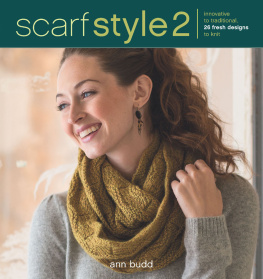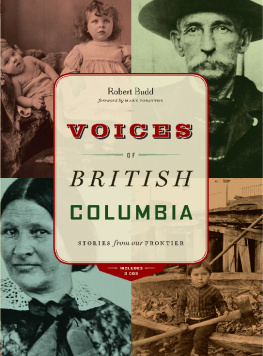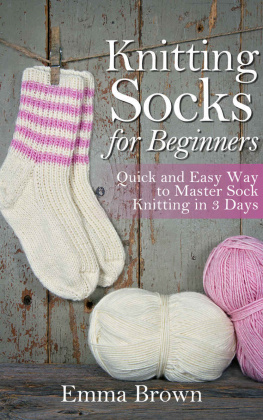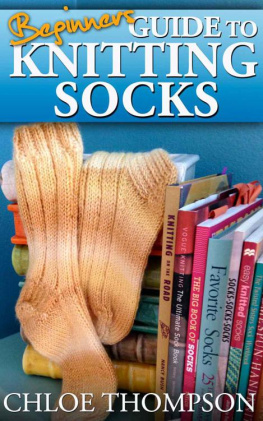This digital eBook is for your private use only. It is not authorized for any other use, including copying and distributing to others.
Getting started knitting socks / Ann Budd, author.
p. cm.
Includes bibliographical references and index.
1. KnittingPatterns. 2. Socks. I. Title.
Acknowledgments
As all books, Getting Started Knitting Socks was not an individual effort.
The projects in this book could never have been knitted without the wonderful yarns produced by manufacturers across the country. Louet Sales generously donated all of the yarn for the basic step-by-step photographs, basic sock patterns, and swatches of stitch patterns. Yarns were also provided by Brown Sheep Company, Cascade Yarns, Coats & Clark, Koigu Wool Designs, Unicorn Books & Crafts, Lion Brand, Lornas Laces, The Wooly West, and Westminster Fibers.
The folks at Interweave Pressparticularly Tricia Waddell, Rebecca Campbell, Anne Merrow, and Linda Starkprovided suggestions and collaboration every step of the way. Lori Gayle ensured that the instructions are clear and correct (if there are any errors, Im to blame). And the book wouldnt be a visual treat without the efforts of Joe Coca, Paulette Livers, Ann Swanson, and Alan Bernhard. To all of you, my sincerest thanks.
I also want to give a nod to my Fun Club friends Jane, Judy, Gail, Maggie, Mary Kay, and Weezie for giving me a break every month, and to my somewhat-weekly knitting pals Ann, Beege, Carmen, Darcy, Heide, Judy, Karen, and Lisa for listening to me go on and on about all aspects of handknitted socks.
Last, but certainly not least, deep thanks to my boys David, Alex, Eric, and Nicholas for patiently waiting for me to finish a row (or round) of knitting before asking me do anything else.
Contents


Ive developed a relationship with handknitted socks thats bordering on a love affair. From the moment I slip on my socks in the morning to the moment I take them off at night, my legs are secretly being hugged, my heels gently cupped, and my feet caressed. While no one is looking, my socks embrace and cushion every step I take. In return they only ask not be put in the dryer. Since I was given my first pair of handknitted socks about ten years ago, Ive gradually forsaken all commercially manufactured substitutes. My feet and I are very happy.
So why are so many knitters hesitant to knit socks? Do they see folly in knitting something that no one sees, or worse, something thats bound to wear out? Do they worry that socks are too complicated to knitall those pointy needles and tricky maneuvers? I suspect that its a little bit of each. But I also suspect that its because they havent experienced the pleasures of handknitted socks firsthand. Put on a pair of handknitted socks and any excuse is trivial. Im now evangelistic in my desire to bring the same pleasure to all knitters (and their friends).
Sure, there are a number of techniques used in sock knitting that dont arise in other projectsdouble-pointed needles, short-rows, picking up stitches, and the dreaded Kitchener stitch. But, when approached one at a time, none of these techniques is any more difficult than learning the basic knit and purl stitches. If you can knit and purl, you can knit your own socks. Follow the clear steps, photographs, and illustrations in this book and youll wonder why you waited so long.
Start by gathering the materials listed in . Once youve mastered your first pair of socks (and I promise you, its not hard), youll eagerly reach for your needles to start another pair. You can choose a variety of sizes and weights of yarn to make dozens of socks following the basic patterns for 4 to 8 stitches to the inch. If you get tired of the basic sock, add some color or textureribs, cables, or lace. Adjust the length of the leg or the type of cuff. To get you started, Ive provided patterns for sixteen variationsfollow the patterns as written or use them as a first step for your own design ideas.
Before you know it, youll start your own love affair.

First and foremost, youll need some yarn. Choosing yarn can be a lot of fun, but the choices can be overwhelming. Youll want to consider the size or weight of the yarn, the fiber content, and the color.
Yarn Weight
Its a good idea to start by deciding on the weight of sock you want. Do you want a thick, rugged boot sock? A thin, delicate stocking? If you want to wear your handknitted socks in shoes, youll need to choose lightweight yarnfingering weight is best, but if your shoes have a loose fit, you can probably use sportweight yarn. Socks worn with loose fitting shoes such as utility boots, clogs, Crocs, Birkenstocks, or Danskos, can be knitted with thicker yarnperhaps as thick as worsted weight. Save chunky-weight yarns for socks that will be worn alone as slippers.

Socks can be knitted with a variety of yarn weights. Clockwise from far left: Chunky-weight yarn at 4 stitches/inch, worsted-weight yarn at 5 stitches/inch, sportweight yarn at 6 stitches/inch, sportweight yarn at 7 stitches/inch, fingering-weight yarn at 8 stitches/inch.
How Much Yarn Will You Need?
The amount of yarn you need depends on the gauge and sock size. In general, the finer the yarn and the bigger the sock, the more yarn youll need. If you plan to add a heavily textured pattern such as cables, youll also need more yarn.


Fiber Content
There are dozens of yarns that make great socks, many of which are marketed specifically as sock yarn. Most commonly, these yarns contain a high percentage of wool due to wools superior absorbency and warmth. If you worry about wool irritating sensitive skin, consider yarns made from merino woolmerino is exceptionally soft, and many people who may be unable to wear wool next to their skin can wear merino socks. Dont give up on handknitted socks if you find any kind of wool uncomfortablethere are cotton and synthetic yarns that are also good choices. See the for some of my favorites. Many dedicated sock yarns include a percentage of nylon that helps make the yarn more durablean important consideration for high-friction areas such as heels and toes. Most knitting shops carry nylon reinforcing thread that can be knitted along with the yarn while working the heels and toes. This reinforcing thread not only prevents holes from forming, it also resists breaking itself. If the yarn does wear away, youll still have the thread holding the socks together and providing a good foundation for darning.
















